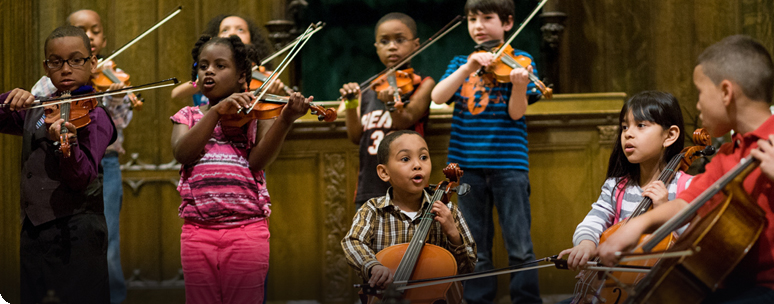Community MusicWorks “happening” on October 18 in New York was a lot like salsa dancing for gringos. It was hard to keep up. It was hard to know what or who to watch – Venezuelan composer Gonzalo Grau or violinist Johnny Gandelsman or CMW players – and even harder to know how this viscerally charged, salsa-art music-classical collaboration was holding together.
Take the dazzling centerpiece Fantasia con Guayaba Habanera, commissioned by CMW in 2013. Before you grasped one sound, something new had started, a rhumba, a pop riff, a different key or mode or Dionysian blast from the trumpets while violinists plucking their strings. Grau composed and arranged this large shifting composition with fast feet and arms wide enough to hold a CMW classical string section, Latin timbals and horns, and a magical violinist, Gandelsman. Under the wide reach of Latin music, forms were present – along with the creative impatience to turn left, try right, get moody, go elegant, charged for maximum effect.
The hall in the DiMenna Center was nearly full with spry little kids sitting on the floor, and a mix of seated New Yorkers who were there for the cultural experience. The composer, being a bit of a tease, gave no hint to the question: “What kind of experience?” That one you’re going to hear, he so much as said, tipping his black bowler. The one you’re going to hear as you travel freely with a creative mind through different musics.
The experience began with a suave master of ceremonies, Jainardo Batista, who crooned, played flute and bounced through two charged Grau compositions. Then CMW Players – 28 violins, viola and cellos – came out to join the composition Moros y Cristianos. Moors and Christians coexisted and clashed in Andalusia, Spain, but the piece was inspired by flamenco, the art form of the itinerant gypsies who live in Andalusia. Grau played a few bars of flamenco to show the complex and brooding underpinnings of the music – how notes move without a clear signal of their return to home key. Also influenced by Islamic and Jewish music, flamenco provokes questions about home. It is comfortable in modes of travel and with a continual redefinition of “home”. It’s music where border crossings are taken for granted, but the forms themselves are rigorously maintained.
This is CMW’s purview – crossing borders from stage to community, from one music to another. In his introductory remarks, Sebastian Ruth explained that CMW had commissioned Grau to compose the piece with the question in mind: Could the Latin music that many Providence CMW kids hear at their family homes mesh with classical forms? What if we tried it? What would it sound like?
The resulting Fantasia con Guyaba Habanera floated one of many possible answers while at the same time, remaining undefinable. It is a sophisticated intelligent work – starting with an extended struggling voice of Gandelsman’s sometime dissonant violin through various dances and forms. The borders of music kept shifting from intellectual to full sensory to big band dance. At the beginning, individual voices played, then politely listened. They became more and more layered until everyone was joyously playing on top of/with each other. What had begun with one voice ended in a singsong communal chant from the audience.
Just before Fantasia came Johnny Gandelsman. He explained that the piece he was performing, Chaconne, is the product of J.S. Bach’s meditating on a Spanish folk dance form as a basis for his classical composition. Gandelsman is a strong physical presence, dipping and swaying, but he dissolved the materiality of the violin to arrive at something freestanding, that existed almost without him. His border crossing was extraordinary as well.
All in all, it was a wonderful evening.
–Jill Pearlman
